| Revision as of 15:55, 1 January 2017 editFrietjes (talk | contribs)Autopatrolled, Extended confirmed users, Template editors1,001,704 editsNo edit summary← Previous edit | Revision as of 13:27, 30 July 2017 edit undo81.151.101.196 (talk) SpTags: Mobile edit Mobile web editNext edit → | ||
| Line 11: | Line 11: | ||
| |Link = http://whc.unesco.org/en/list/1110 | |Link = http://whc.unesco.org/en/list/1110 | ||
| }} | }} | ||
| The '''Historic |
The '''Historic Centre of Macao''', also known as the '''Centro Histórico de Macau''' ({{zh|t=澳門歷史城區}}; {{lang-pt|Centro Histórico de Macau}}), is a collection of over twenty locations that witness the unique assimilation and co-existence of Chinese and Portuguese cultures in ], a former ]. It represents the architectural legacies of the city's cultural heritage, including monuments such as urban squares, streetscapes, churches and temples. | ||
| In 2005 the Historic Centre of Macau was inscribed on the ] ], making it the 31st designated World Heritage site in ]. It was described by UNESCO as: "with its historic street, residential, religious and public Portuguese and Chinese buildings, the historic centre of Macao provides a unique testimony to the meeting of aesthetic, cultural, architectural and technological influences from East and West," and "...it bears witness to one of the earliest and longest-lasting encounters between China and the West, based on the vibrancy of international trade."<ref></ref> | In 2005 the Historic Centre of Macau was inscribed on the ] ], making it the 31st designated World Heritage site in ]. It was described by UNESCO as: "with its historic street, residential, religious and public Portuguese and Chinese buildings, the historic centre of Macao provides a unique testimony to the meeting of aesthetic, cultural, architectural and technological influences from East and West," and "...it bears witness to one of the earliest and longest-lasting encounters between China and the West, based on the vibrancy of international trade."<ref></ref> | ||
Revision as of 13:27, 30 July 2017
UNESCO World Heritage Site| UNESCO World Heritage Site | |
|---|---|
 | |
| Location | Macau |
| Criteria | Cultural: ii, iii, iv, vi |
| Reference | 1110 |
| Inscription | 2005 (29th Session) |
The Historic Centre of Macao, also known as the Centro Histórico de Macau (Chinese: 澳門歷史城區; Template:Lang-pt), is a collection of over twenty locations that witness the unique assimilation and co-existence of Chinese and Portuguese cultures in Macau, a former Portuguese colony. It represents the architectural legacies of the city's cultural heritage, including monuments such as urban squares, streetscapes, churches and temples.
In 2005 the Historic Centre of Macau was inscribed on the UNESCO World Heritage List, making it the 31st designated World Heritage site in China. It was described by UNESCO as: "with its historic street, residential, religious and public Portuguese and Chinese buildings, the historic centre of Macao provides a unique testimony to the meeting of aesthetic, cultural, architectural and technological influences from East and West," and "...it bears witness to one of the earliest and longest-lasting encounters between China and the West, based on the vibrancy of international trade."
List of sites
The Historic Centre of Macao is made up of two separated core zones in city center on the Macau peninsula. Each core zone is surrounded by a buffer zone.
Zone 1
The narrow-stripped Zone 1 is located between Mount Hill and Barra Hill.
Buildings
| Name | Location | Notes | References | Photo | |
|---|---|---|---|---|---|
| A-Ma Temple | Barra Square 22°11′10″N 113°31′52″E / 22.186111°N 113.531139°E / 22.186111; 113.531139 (A-Ma Temple) |
Built in 1488, the temple is dedicated to Matsu, the goddess of seafarers and fishermen. The name Macau is thought to be derived from the name of the temple. |  | ||
| Moorish Barracks |  | ||||
| Mandarin's House |  | ||||
| St Lawrence's Church | 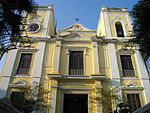 | ||||
| St. Joseph's Seminary and Church | 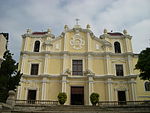 | ||||
| Dom Pedro V Theatre | St. Augustine's Square | 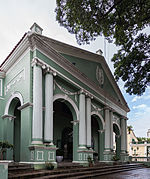 | |||
| Sir Robert Ho Tung Library | St. Augustine's Square |  | |||
| St. Augustine's Church | 3 St. Augustine's Square | 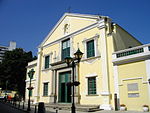 | |||
| Leal Senado Building | Senado Square | 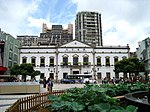 | |||
| Sam Kai Vui Kun (Kuan Tai Temple) |
10 Rua Sui do Mercado de São Domingos |  | |||
| Holy House of Mercy | Senado Square |  |
|||
| Cathedral of the Nativity of Our Lady | 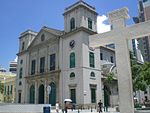 |
||||
| Lou Kau Mansion | 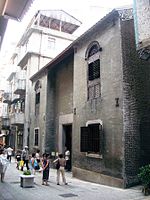 | ||||
| St. Dominic's Church | St. Dominic's Square | 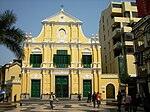 | |||
| Ruins of St. Paul's |  | ||||
| Na Tcha Temple | 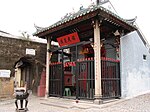 | ||||
| Section of the Old City Walls |  | ||||
| Monte Forte |  | ||||
| St. Anthony's Church |  | ||||
| Casa Garden | 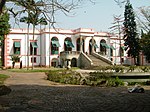 | ||||
| Old Protestant Cemetery and the old headquarters of the British East Indies Company | 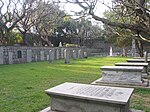 |
Squares
| Name | Location | Notes | References | Photo |
|---|---|---|---|---|
| Barra Square 媽閣廟前地 Largo do Pagode da Barra |
||||
| Lilau Square 亞婆井前地 |
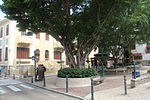 | |||
| St. Augustine's Square 崗頂前地 |
 | |||
| Senado Square 議事亭前地 |
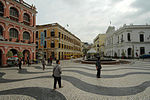 | |||
| St. Dominic's Square 板樟堂前地 |
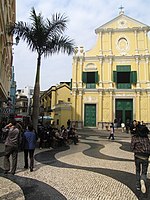 | |||
| Cathedral Square 大堂前地 |
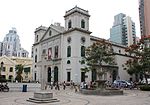 | |||
| Company of Jesus Square 耶穌會紀念廣場 |
The square in front of the Ruins of St. Paul's. |  | ||
| Camoes Square 白鴿巢前地 |
 |
Zone 2

The Zone is surrounded by a buffer zone that covers a park and immediate urban area.
- Guia Fortress incorporating Guia Chapel and Guia Lighthouse
Management
Most of the items (buildings) are owned by the Macau Special Administrative Region (SAR) and managed by various departments or authority. Cultural Institute of the SAR Government manages the Mandarin's House, the Ruins of St. Paul's, the Section of the Old Wall, Mount Fortress and Guia Fortress (includes the Lighthouse and Chapel).
Leal Senado Building is managed by the Provisional Municipal Council of Macao while the two government-owned temples, A-Ma Temple and Na Tcha Temple are managed by the Board of A-Ma Temple Charity Association and Management Board of Na Tcha Temple respectively. The Moorish Barracks is managed by the Macao Harbour Administration Building.
The rest of the items are owned and managed by the respective institutions. St. Joseph's Seminary Building and Church is owned by St. Joseph's Seminary and managed by the Catholic Diocese of Macao. The Holy House of Mercy Building is owned and managed by Holy House of Mercy Charitable Foundation. Dom Pedro V Theatre is owned and managed by the Management Board of Dom Pedro V Theatre.
The nominated buildings of the Historic Center are protected by various laws, including the Basic Law of the Macao SAR.
See also
References
- Historic Centre of Macau. UNESCO World Heritage Centre
- ^ "Advisory Body Evaluation (of Historic Centre of Macao)" (PDF). UNESCO. 2005. Retrieved 2009-05-01.
- The Map, Historic Centre of Macao
- ^ "Nomination file submitted to UNESCO" (PDF). UNESCO. 2005. Retrieved 2009-05-03. Cite error: The named reference "Nomination File" was defined multiple times with different content (see the help page).
External links
- Official website
- Information from the website of UNESCO World Heritage Centre
- 1001wonders.org : visit this site in panophotographies - 360 x 180 degree images
| World Heritage Sites in China | ||
|---|---|---|
| East |
|  |
| South Central |
| |
| Southwestern | ||
| North | ||
| Northeast | ||
| Northwestern | ||
| Multiple regions |
| |
22°11′28″N 113°32′10″E / 22.191°N 113.536°E / 22.191; 113.536
Categories: